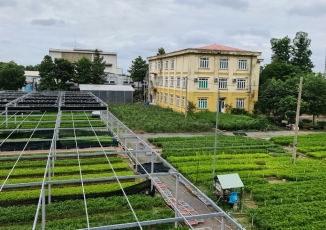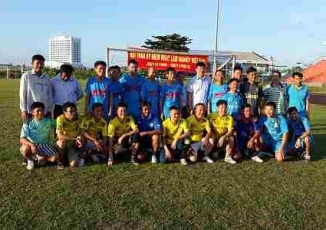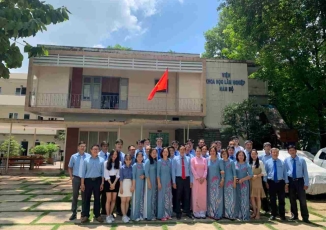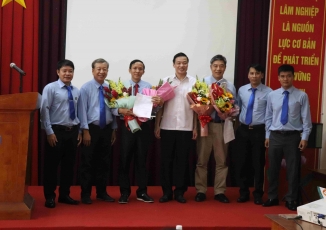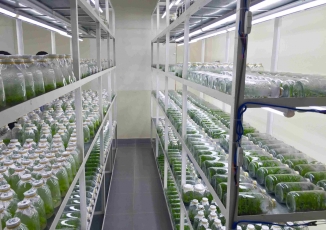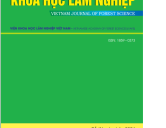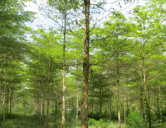Hoạt động kh&cn
Improving productivity and sustainability of successive rotations of Acacia auriculiformis plantations in South Vietnam
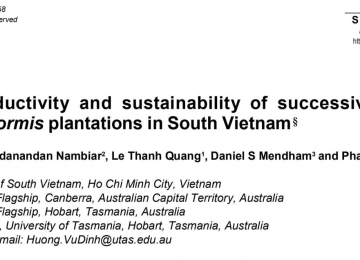
We studied the productivity of Acacia auriculiformis plantations in South Vietnam over three successive rotations covering 15 years. The focus of our study was on the effects of inter-rotation management on stand growth and soil properties. Contrastin g slash and litter management treatments were applied at the start of the sec ond rotation, and reapplied at the start of the third rotation with an additional phosphorus fertiliser treatment. There were improvements in the genetics of planting stock, weed control and stocking with each rotation. Average growth rates (mean annual increment) increased from 10.6 m3 ha−1 y−1 in the first rotation (age 7 years) to 28.3 m3 ha−1 y−1 in the second rotation (age 6 years) and to 33.9 m3 ha−1 y−1 at age 5 years in the third rotation. Removal of slash and litter after harvesting the first rotation removed 20.2 Mg ha−1 biomass, containing 169.6, 13.9, 76.3 and 25.1 kg ha−1 of nitrogen (N), phosphorus (P), potassium and calcium, respectively, from the site. Greater amounts were removed after the second rotation commensurate with higher amounts of biomass produced. Slash and litter removal reduced growth of the second rotation by 13% compared to their retention. Soil organic carbon (C) in the 0–10 cm soil layer increased from 16.7 g kg−1 at the end of the first rotation to 22.8 g kg−1 at the end of the second rotation with a corresponding increase in soil N from 1.2 g kg−1 to 1.7 g kg−1. Over the same time, soil organic C and N contents were 26% and 40% greater, respectively, in treatments with slash and litter retained compared to initial levels before treatment application. In the second rotation, extractable soil P declined and in the third rotation there was a response to added P. Overall results demonstrate that there is an opportunity to increase and sustain production of A. auriculiformis over at least three rotations by integrated management practices promoting better stocking, planting of genetically improved stock, organic matter and nutrient conservation, and judicious weed management.
Growth and physiological responses to intensity and timing of thinning in short rotation tropical Acacia hybrid plantations in South Vietnam
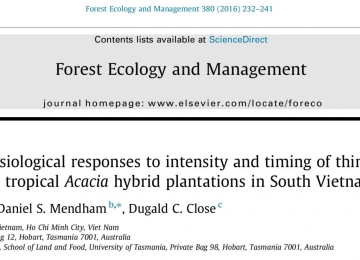
Acacia hybrid plantations are widely planted for pulpwood in Vietnam, but have the potential to be managed for high value saw-logs. This study examined the growth and physiological responses to thinning as a management option to increase the sawlog yield and value. Treatments were: unthinned (planting density 1111 trees ha−1), thinned to 833 or 600 trees ha−1 in a single thinning at either age 2 (early) or 3 (late) years, and progressively thinned from 1111 to 833 trees ha−1 at age 2 years, and then to 600 trees ha−1 at age 3 years. Three years after early thinning to 600 stems ha−1, mean stem diameter was increased by 16.7% and the stand volume was reduced by 15.8%; thinning to 833 stems ha−1 resulted in no significant loss in stand volume and increased mean diameter by 7.5%. The leaf area index, LAI of stands thinned to 600 stems ha−1 recovered rapidly and there was no significant difference between unthinned and thinned treatments 1 year after thinning; this recovery was also associated with a reduction in litterfall. Thinning to 600 stems ha−1 increased A1500 of the lower crown by 23.5 and 17.4% at age 2 and 3 yr, respectively; and this was associated with increased foliar phosphorus concentration. Thinning reduced leaf water stress during the dry season; leaf water potential and tree growth were significantly influenced by season. It was concluded that thinning to 600 trees ha−1 at age 2 years or to 833 trees ha−1 at age 3 years will produce wood with the highest diameter.
Returns to Vietnamese smallholder farmers from managing acacia plantations for sawn wood over 4-10 year rotations
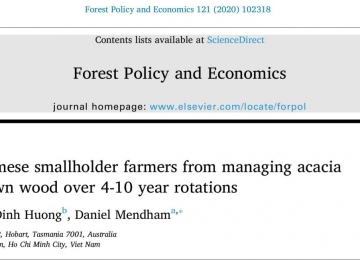
Since 1990, forest area in Vietnam has increased by around 15%, and now comprises more than 42%. The increase is mainly due to the establishment of short rotation Acacia plantations, which assist in the rehabilitation of under-utilised lands, and can be grown in short rotations by smallholder farmers for a range of uses. Presently, a high demand for woodchips encourages farmers to maintain short rotations for pulplogs and provides them with a relatively quick return from their forestry land. The Vietnamese Government has recognised an opportunity to increase sawlog production for a rapidly expanding furniture industry. The main objective of this study was to understand if small-scale Acacia plantations, managed for both pulp- and sawlog production, could provide an attractive return to smallholder farmers. Forecast earnings from the models indicated that opportunities exist for smallholders to improve their financial returns. With minimal additional inputs, plantations with a thinning intervention treatment at 3-years would be more profitable than unthinned ones, irrespective of whether the plantations were harvested in year 4 through to year 8. In 4 to 8-year rotations, the 6-year thinned operation was modelled as being the most profitable. When plantation models were extended to 10-years, the returns were even higher because of the greater volume of larger diameter higher value sawlogs. Sensitivity modelling found shorter rotation returns were highly sensitive to factors influencing income, whereas 10-year rotations were shown to be more resilient, although the growers would need to manage their risk profile, as well as acquire the knowledge and management skills required to effectively manage longer rotations. Outcomes from the study suggest that growing for sawlogs is a better option for farmers, in terms of the internal rate of return. A transition from short to longer rotations will require support for farmers, in terms of: (1) risk management, (2) training in longer rotation management, and (3) greater social acceptance of longer rotations.
Growth, physiological responses and wood production of an Acacia auriculiformis plantation in southern Vietnam following mid-rotation thinning, application of phosphorus fertiliser and organic matter retention

Acacia auriculiformis plantations are widely planted in Vietnam. Initially they were grown for wood chip production, but these plantations have potential to be managed for higher value sawing and/or peeling grade logs, through enhanced silvicultural management. This study sought to understand the impact of resource constraints on responses of A. auriculiformis plantations to thinning, phosphorus fertiliser application and slash retention at age four years on growth and physiology of A. auriculiformis trees to rotation end at age nine years. A trial in South Vietnam had a factorial combination of thinning (unthinned (planted at 1666 trees ha−1), or thinned to 833 trees ha−1), P fertilizer (Nil, or 50 kg P ha−1), and organic matter manipulation (slash and litter retained or removed).
Solid wood property variations in early-age Acacia plantation trees grown in southern Vietnam
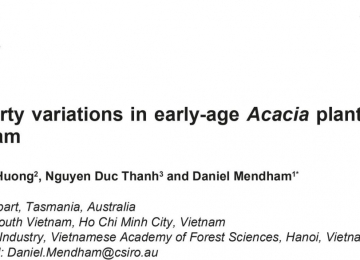
A high demand for woodchips has encouraged smallholder farmers in Vietnam to invest in short-rotation Acacia plantations to produce pulpwood that has a relatively quick, though often low, income return. Because of an expanding export furniture industry, the Vietnam Government has sought to increase sawlog production and, at the same time, improve returns to smallholder farmers. However, currently the quality and therefore market value of the timber from acacias under differing management strategies has not been well quantified. Acacia auriculiformis, both in its pure form and its hybrid with A. mangium (Acacia hybrid) are grown in plantations in Vietnam to produce merchantable timber, though the inferior mechanical properties of juvenile wood at an early age has impeded access to higher-value product markets. However, with thinning, there may be improvements in wood properties that could enhance sawlog values. This study examined how the wood properties of plantation grown Acacia hybrid change with stand age, explored differences in wood properties between Acacia hybrid and A. auriculiformis following different thinning treatments, and determined which of the two species is the most favourable for solid wood products. The potential to supply logs to produce sliced veneer for the furniture industry was also investigated. Logs from A. hybrid trees aged eight years could be processed to manufacture structural products, and at age five years for manufacturing utility furniture. Acacia auriculiformis thinned to 833 stems per hectare at age 4 years had mechanical wood properties indicating a potential for durable flooring products that can command a high value in the market. Because of dead knots, most sliced veneer samples were not acceptable for face veneer, though visual assessments indicated that with pruning, an attractive high-value product could potentially be produced. Tree species rather than age or thinning treatment had the most influence on wood properties.
VIDEO CLIPS
Liên kết
Ấn phẩm mới
Thống kê truy cập
Đang online: 14
Truy cập ngày: 17436
Tổng truy cập: 280117






